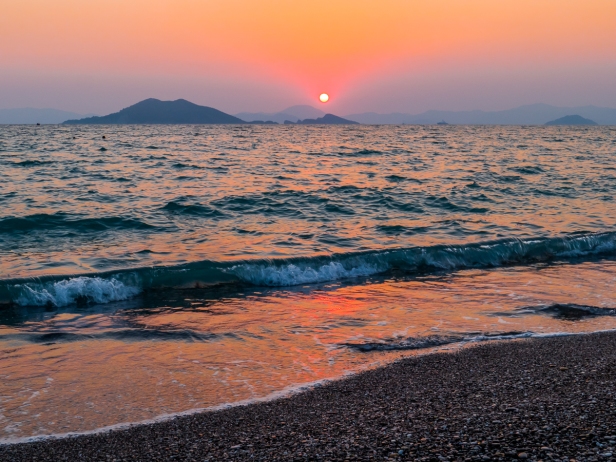
3-7 September 2015. It is an easy two-hour drive from Marmaris to Fethiye. We walk into our hotel room and fall in love. Suddenly, unexpectedly, we have arrived in paradise. The whole front wall of our room is glass and looks out over the deep turquoise Mediterranean. It opens onto a balcony. We are surprised and overjoyed by the splendor of our circumstances. Please can we stay here forever? We immediately decide to stay a second day and give up a day in Antalya, our planned next stop.
A lazy afternoon; we will go down to the water eventually but for now we are content just to look at it. It is very hot as usual. Since Izmir it has been in the mid thirties or higher (95+) every day. Later we take a walk along the pedestrian-only walkway, the beach on one side, restaurants and bars on the other.
We find a place for dinner with agreeable music: blues and jazz instead of the usual screaming disco-bubblegum pop.
Early one morning we climb up to the Lycian cliff tombs that overlook the town. Some of them are over two thousand years old, hand hewn into the cliff sides. I am trying to imagine people, probably hundreds of them, scaling these cliffs and carving huge edifices from the sandstone, with perfectly straight horizontal and vertical lines, perfectly formed Ionic columns. How did they do that? It seems incredible to me.
The Lycians were an Anatolian people dating from as long ago as 3000 BC. It is known that by 2000 BC they had strong land and sea forces, and were an independent state. They inhabited the compact mountainous area in the southwest of Turkey along and inland from the Mediterranean coast.
There is little historical record of them, but what is known tells of a people culturally divergent from the rest of the ancient world. They were most likely a matriarchal society. The Greeks revered the Lycians for having solved the problem of balancing free government in smaller communities with the needs of the greater political whole. The Lycians were the first democratic union and valued their unity while Greek city-states were still constantly at war with each other.
I’d not heard of the Lycians until we read that we’d be able to see some of their magnificent rock-cut tombs, dating back to 400 BC, during our cruise of Dalyan River. The more elaborate tombs were the resting places of kings. Throughout the Lycian region one thousand and eighty-five tombs of various types still survive.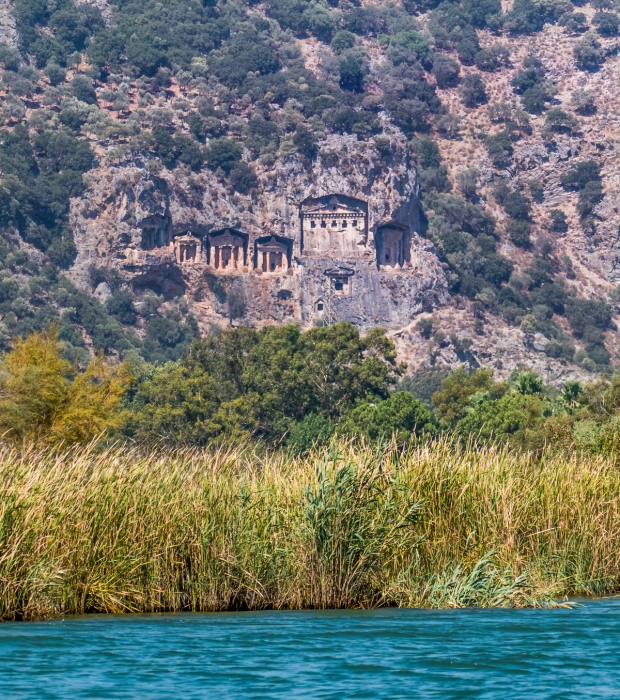
The Lycians believed their dead were carried to the afterlife by magical winged creatures so their dead were placed as high as possible to facilitate the journey. The more important the person, the higher the tomb. The exteriors for royalty were intricately carved, while the older tombs, and those for “lesser” mortals were unembellished holes dug into the cliff face. The interiors are unremarkable – sparse chambers with a simple platform for the body, and now after years of looting they are otherwise empty. The entrance was sealed with a sliding stone door that ran sideways along a groove. The most elaborate are carved in the form of Ionic temples, the largest and most famous being the Tomb of Amyntas overlooking the town of Fethiye.
I was disappointed that we were not able to climb up to the temples that overlook the Dalyan River, so I’m pleased to discover we can do it in Fethiye. The climb is worth it. We are rewarded with panoramic views of the city and a closer look at these ancient wonders, still remarkable despite the graffiti.
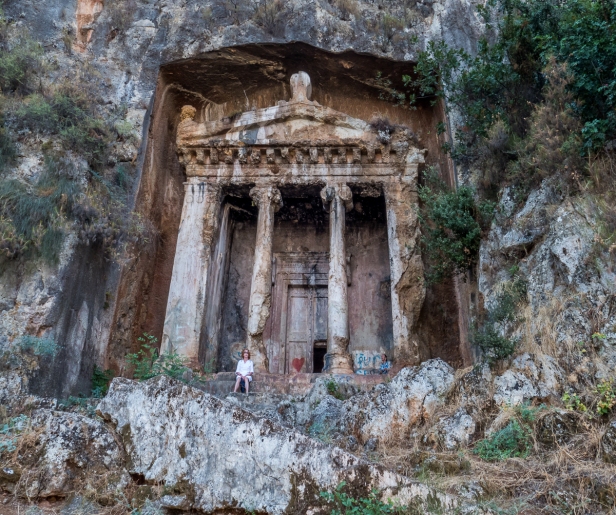
Stopping at the ancient tombs during the Dalyan River cruise I notice several young girls in their bikinis posing with the tombs in the background. Photos, it seems, are no longer about the place, they are about ME at the place, me looking cute and sexy at the place, me showing off where I’ve been, what I’m doing. It’s all about me. The posing is truly clichéd and corny. One is lounging with bent leg, another with her boyfriend by her side stands on one leg on tippy toes with the other leg bent up and a sex kitten pout on her face. Take a photo of my boyfriend and sexy me! I watch bemused. They don’t even look at the tombs. But just to make sure this is an equal opportunity rant here is a photo of me snorkelling on yet another Mediterranean boat cruise ☺

This is our third cruise on the Turkish Riviera. There’s a thing in this part of the world: a “Blue Cruise”, or “Turquoise Cruise”. You live on board a gulet (a traditional Turkish boat) for anywhere from three to seven days as you cruise the coast. We looked at prices and our overall itinerary and decided not to do it but instead opted for three separate day-cruises. This third from Fethiye is almost as good as the first from Bodrum.
We stop in three different places to swim and snorkel in the crystal clear water. Underwater in deeper water the opaque white misty shafts of sunlight go straight down converging together the deeper they go. In shallow water the sunlight dances. It is yellow and forms small wavy circles, or multi-sided wavy shapes, one joined to another to another. Through the light I see a huge school of hundreds of tiny fish about three centimetres long, silver with a flash of blue, hundreds of them swimming in formation turning as one unit as if they are one being. Perhaps it is safer that way.
On board, 

there are about twenty people, all Turkish or Brits, and us. The music ranges from the Eagles Hotel California to Whitney Houston I will always Love you to Pavarotti Miserere to the country tune It’s Five o’clock Somewhere to R&B to Eric Clapton to Elvis to Rod Stewart to Jerry and the Pacemakers. I love the eclectic mix.
We stop to fish for lunch.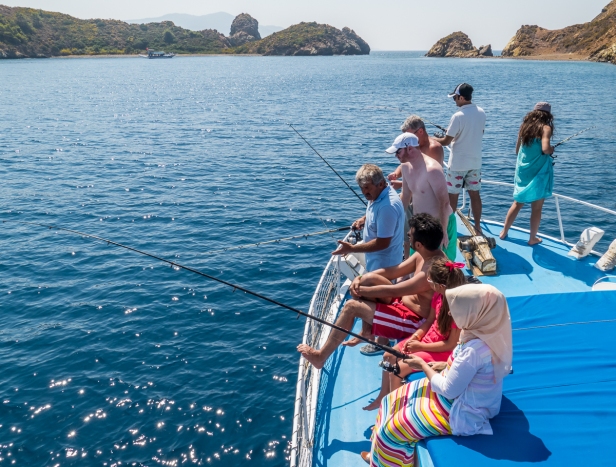
This woman,
who works on the boat, catches dozens, pulling in line after line each with several fish dangling from it. She obviously has done it many times, but is still overjoyed with her success. I suspect that without her we wouldn’t have had more than a small taste. They are the same type of fish I saw while snorkelling. Now they are lunch.
The fish are fried, and the captain barbecues chicken kebabs. 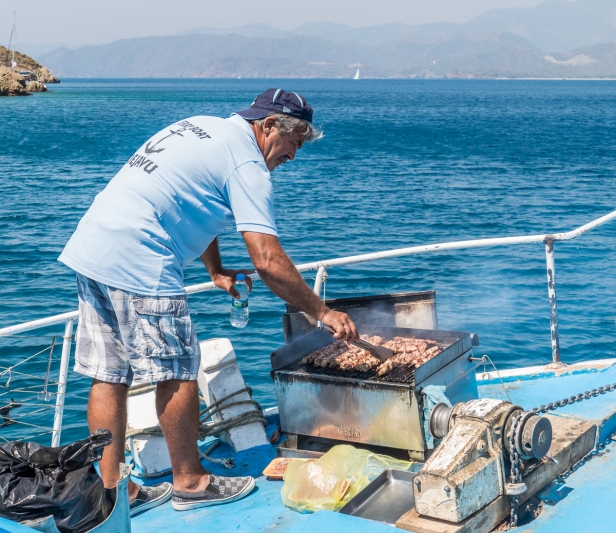
They are served with fries and many salads. It is sumptuous.
We laze on the boat, snoozing on the mats on the upper deck, everyone languid and comatose from the heat and the activity of the day. There is nothing that needs alertness or attention so all energy seeps away and resting happens: deep resting in the sun and this all-blue world.
In Fethiye we explore the Grand Bazaar offering exquisite Turkish crafts,
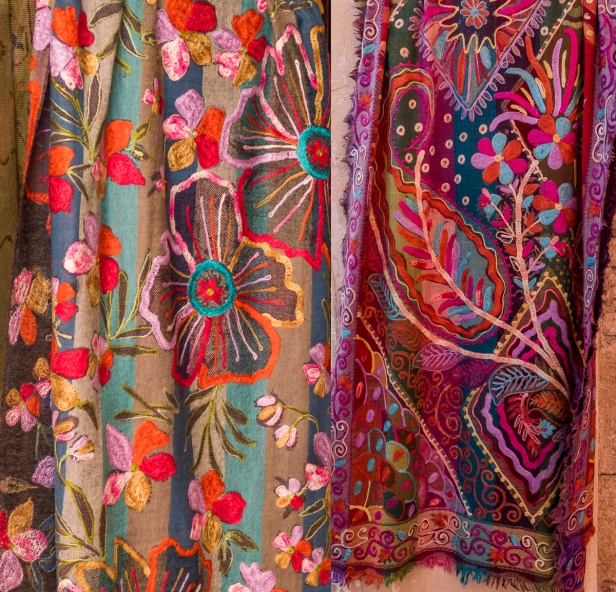

and climb the stairs to the oldest part of town.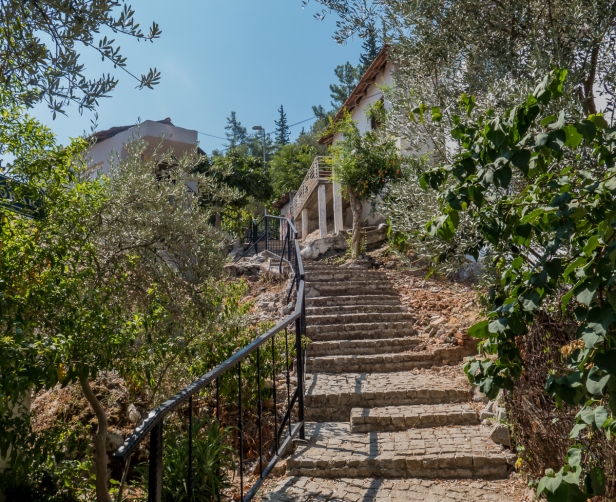
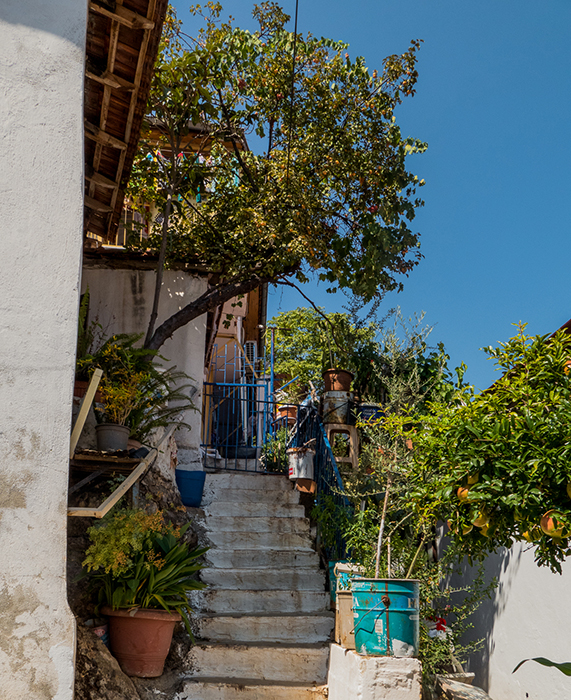
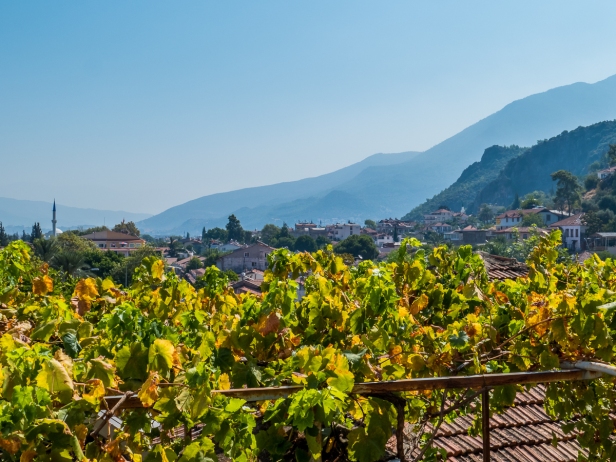
Wandering further away from the central hub into the back streets we find some of Fethiye’s older residents relaxing in front of their homes.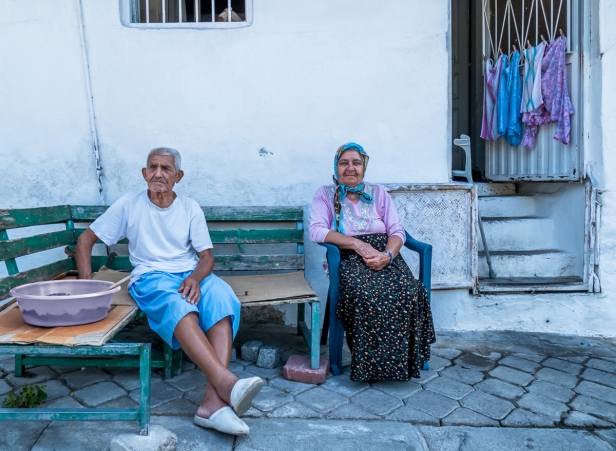
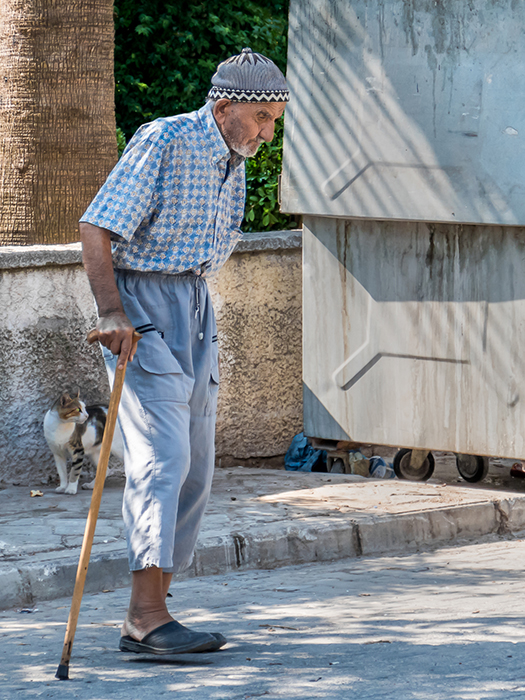

Back at our hotel on the beach a little out of town we watch the sunset from our balcony as the sounds of vacation life drift up to us. Below us is one long strip of restaurants – people talking, laughing, sounds of silverware on plates, soft music, the waves beating rhythmically ashore in the background like a metronome. A soft sultry summer evening when all is right with the world.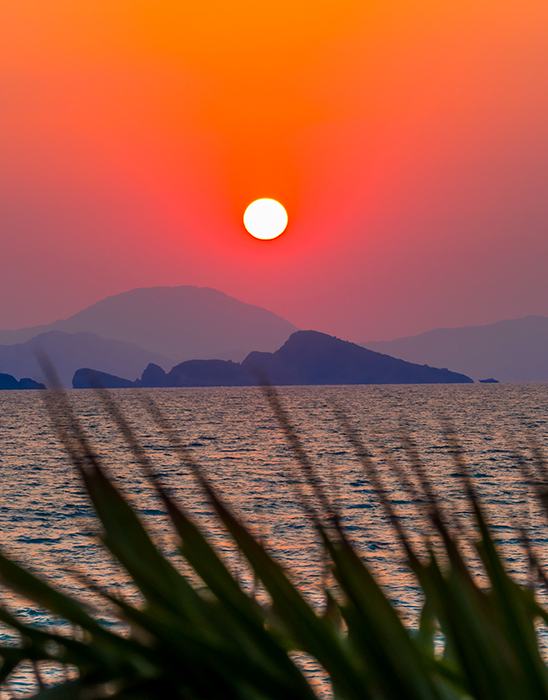
And next morning, a little after sunrise, this is the tranquil scene from our balcony.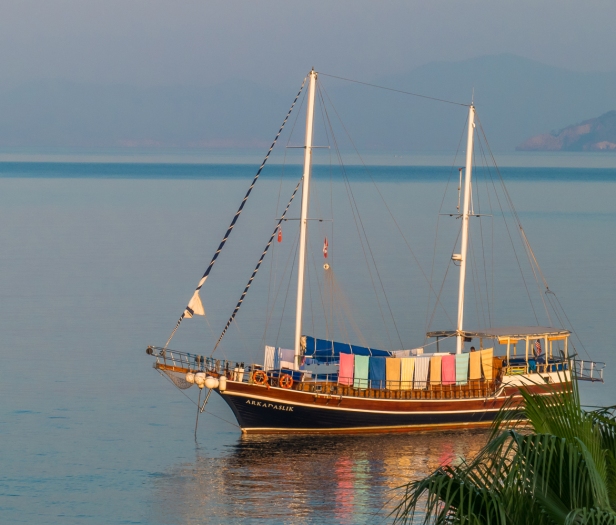
It is two hundred kilometres (124m) from Fethiye to Antalya. Don drives the first half. It is a tense time – narrow roads and enthusiastic Turkish drivers. By the time it’s my turn to drive there is little traffic and we are on dual carriageway: a lucky break for me. Arriving in town it’s impossible to find our way to our hotel, which lies within the old city walls. We eventually find a place to park and walk to the hotel. The hotel owner walks with us back to the car and shows us how to negotiate the maze of streets to the entrance to the Kaleiçi.
Kalesi is Turkish for fortress. Kaleiçi means within the fortress walls. The entire Kaleiçi, or old town, is a grand museum,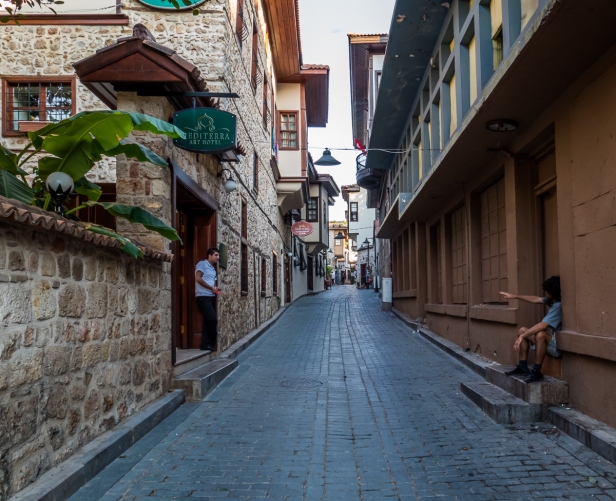
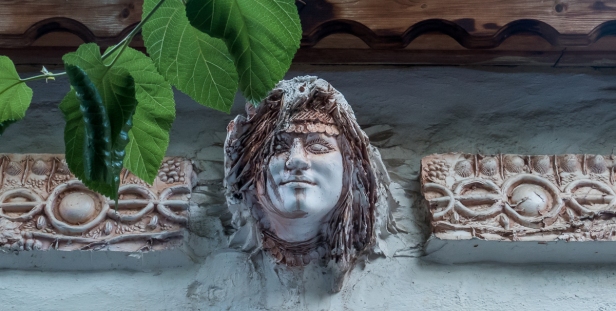
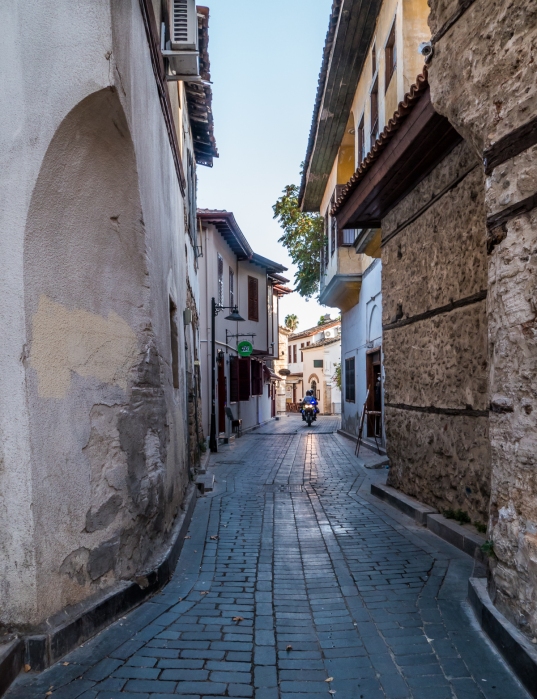
with 21st century entertainment.
It is 39 degrees (102). We are back in the “dripping days”. When it is this hot your whole body is damp, all the time. There is no help for it. We set out to explore anyway, and even in the heat still manage to walk ten kilometres.
Attalos II, king of Pergamon, founded the city in 150 BC and it was named Attalia in his honour. It became a Roman city after the death of the last Pergamene king in 133 BC. It was a prosperous port surrounded by thick defensive stone walls that still exist today.
There were four gates. The grandest, and the only one surviving, is Hadrian’s Gate. It is an immense triple-arched entryway modeled on the Roman triumphal arch. It was constructed in 130 AD to commemorate Emperor Hadrian’s visit to the city.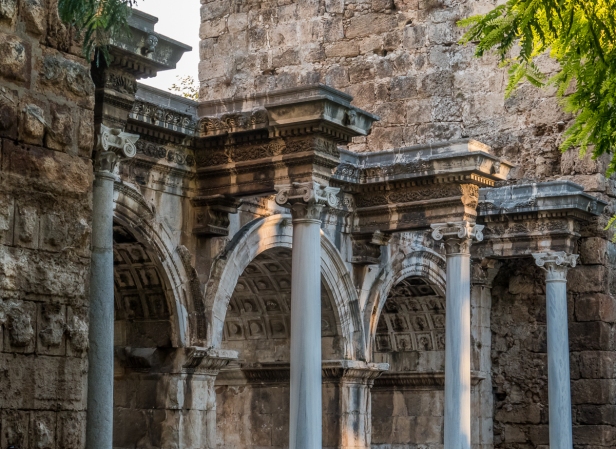
Outside the walls, next to Hadrian’s Gate, there is a shady park where people gather,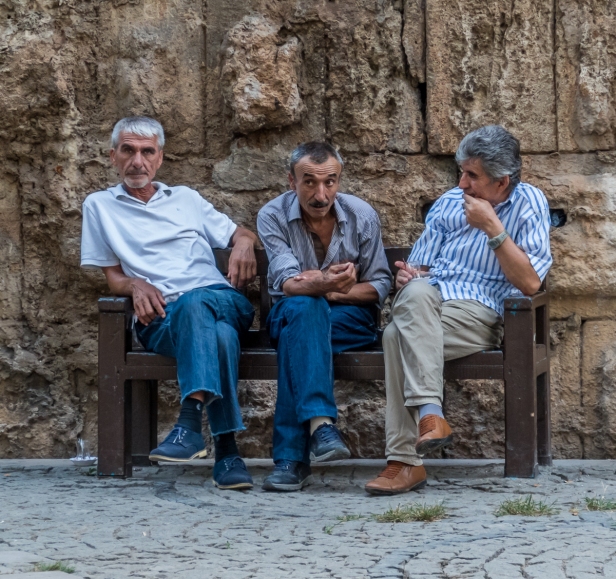
and beyond the walls is a modern metropolis of one million people. Antalya is Turkey’s largest Mediterranean port. The old town is not a tourist destination. Most tourists to Antalya go to the beach resorts up and down the coast and seldom leave them. We find the streets largely empty and quiet.
Taking a break from our explorations we stop at a café. I have iced peach tea, and enjoy the simple pleasure of watching as Don stirs honey into his mint tea, which is served in the traditional glass cup. I watch the mint leaves swirling round and around in the golden liquid, mesmerized. It is hot. We are enervated. It’s a slow day. We drink our tea and wonder about the etymology of the word sofa since the museum of Kaleiçi has a sofa, or courtyard, in the traditional Turkish house. Perhaps it is where they lounge around. I discover later that the word sofa comes from the Arabic suffa but I’m none the wiser since I don’t know what suffa means. Also the usual Turkish word for courtyard is avlu.
We go to the big archaeological museum by tram and on the tram Don is happy like a five-year-old. The museum is huge with an astonishing collection from all the nearby Roman, and pre-roman ruins. I’m always amazed by the skills people had so long ago. Two to three thousand years ago – beautiful jewellery, tiny (and larger) perfectly formed glass vials, exquisite pottery as beautiful as any to be seen today. There are many huge statues of Roman emperors and gods. Some are really magnificent.
I’m also astonished by the way archeologists can piece together shattered pots and statues, like jigsaw puzzles, but I have a short attention span in the museum. I can only look at so many flints, pots, and sculptures. We go home for a rest, stopping for good Italian ice cream on the way. We don’t like Turkish Ice cream. We subsequently discover that it is made from goat milk.
We venture out again later. We find the small private “beach” at the bottom of a long flight of wooden stairs. It consists of a collection of closely spaced lounge chairs on rock shelves and wooden platforms built out over the water.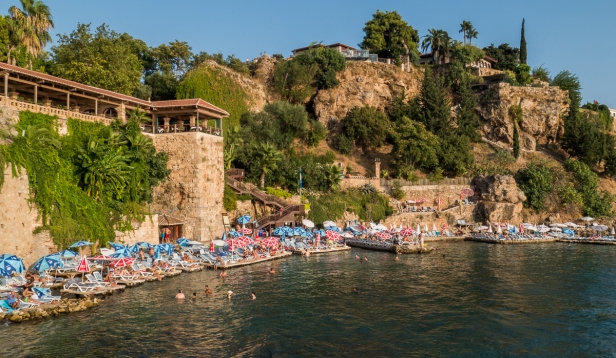
We continue on to the harbour, and then climb up to the top of the city walls.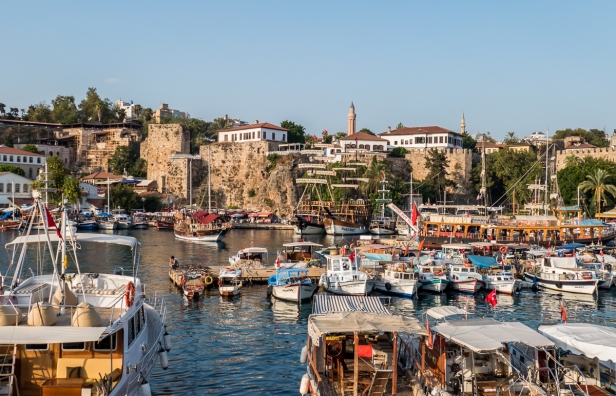
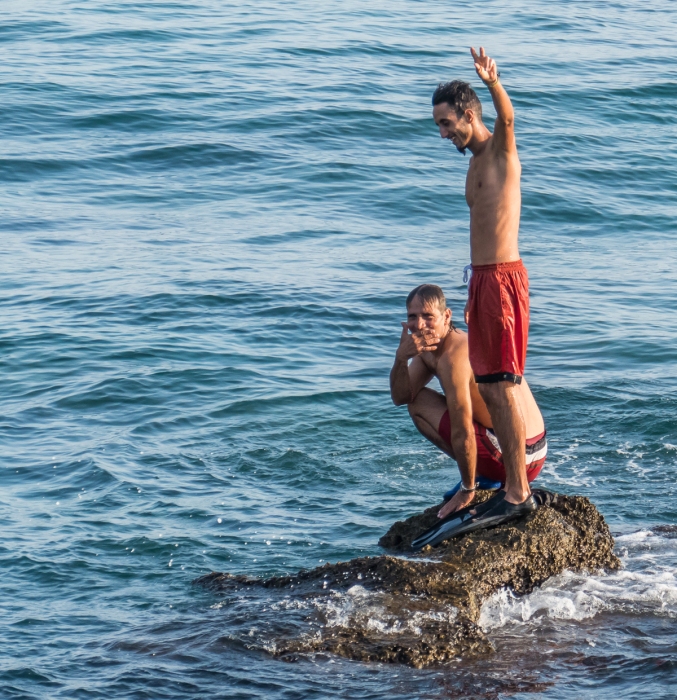
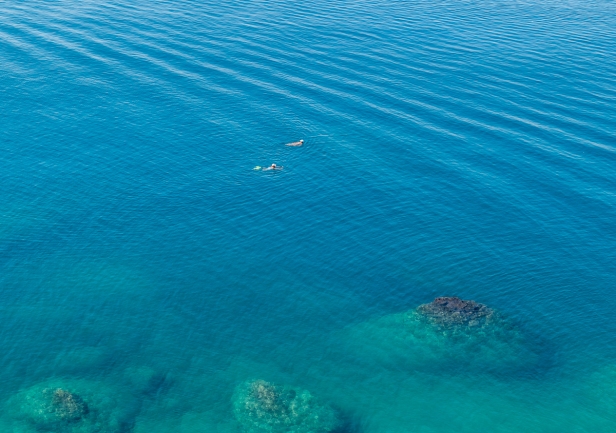
Antalya is our last stop on the Turkish Riviera. We didn’t really know what to expect, and it is better than we could have imagined: eleven days in a sun-soaked blue-water world.
Next post: from Antalya we drive to the extraordinary travertine terraces of Pamukkale. It is my greatest disappointment of all our travels in Turkey, and perhaps of all our travels ever.
All words and images by Alison Louise Armstrong unless otherwise noted
© Alison Louise Armstrong and Adventures in Wonderland – a pilgrimage of the heart, 2010-2016.

What a lively combination of visuals and experiences. I particularly appreciate the portraits of the villagers. The faces reflect intense characters.
We were in Turkey about a year ago, but as it was winter, we skipped the beaches…. Perhaps we will get back there sometime. Looks as though you had a great time.
We recently enjoyed snorkeling in Bali, it’s so much fun to be submerged in an underwater world.
LikeLiked by 1 person
Thanks Peta. I very much enjoy photographing the people wherever we go – it’s lovely to have some contact, even if there is usually no common language.
We did have a great time on the Turkish Riviera, even if most of the places we went were very touristy.
We’ve been snorkelling in Bali too! It’s beautiful isn’t it. Snorkelling in warm tropical waters is one of my favourite things to do. If ever you get the chance you must get to the Great Barrier Reef (if you haven’t been already) – there’s nothing like it!
Alison
LikeLiked by 1 person
beautiful expression
of Turkey’s ancient past
& recent joyful adventures
which fill me with smiles
from the riches of this beauty 🙂
LikeLiked by 1 person
Thank you smilecalm
Happy you are
filled with smiles
for our delicious time
in Turkey.
Alison xox
LikeLike
I’m glad you enjoyed Fethiye—as I mentioned, it was my favourite. The view from your balcony is exquisite, and I love the people photos in the town’s back streets. Sorry to hear about your disappointment in Pamukkele, though I’m interested in reading about it. I loved it there (but that was over 20 years ago).
LikeLiked by 1 person
Thanks Caroline. We did enjoy Fethiye. We actually stayed on the beach at Çalis Plaji, a little out of town, but had time to explore Fethiye as well. I always love wandering the back streets – they are often the most interesting. I bet you had a far better experience at Pamukkele 20 years ago than we did 😦
Alison
LikeLike
Wonderful as always Alison!
LikeLiked by 1 person
Thanks Cindy.
Alison xox
LikeLike
Good Lord, that sunset! And I get what you mean about it suddenly not anymore about a place but about “me” being in the place. I see it a lot — I’m guilty of it every now and then — and I can’t help feeling it somehow takes away from the experience, if you’re too focused on capturing the moment and not simply enjoying just being in it.
LikeLiked by 1 person
Thank you! Isn’t that sunset fabulous! I admit – I played with it in Photoshop 🙂
I think Don and I have only ever taken one selfie – right after Don got his first smart phone (I still don’t have one) and it got more likes on FB than any other photo I’ve posted!
I agree that selfies especially, and photography in general, can take away from being in the moment and enjoying where you are. I try to find a balance, but sometimes I get lost in trying to get “the” photograph and miss the experience 😦
Alison
LikeLike
Such a detailed post filled with history and the lovely description of these towns! Pictures of the cliff tombs looks so amazing, can’t imagine how people during that age made it possible to construct those tombs! Your pictures have taken us on a virtual tour of these places!
LikeLiked by 1 person
Thank you so much. The cliff tombs *were* amazing. I don’t think I’d never seen anything like them, though a few weeks we were at Petra in Jordan where there is something similar, and equally stunning.
I’m glad you enjoyed the tour 🙂
Alison
LikeLike
Love your photos, especially the rich colours of the fish hooks and lamps. And the ones of the villagers. Who would not want to plan a trip to Turkey after a post like this? I can’t wait for your post on Pamukkale. On a recent trip to Turkey I intentionally skipped Pamukkale as I wanted to remember it as it was from a stay in 1973. I’m thinking that decision may be validated.
LikeLiked by 1 person
Thanks Anne. I’m glad you enjoyed the post. We loved Turkey. Just about everywhere we went (except Pamukkele but that’s a story for the next post) people were friendly and places fascinating and beautiful. As you well know Turkey is definitely worth visiting. Your decision re Pamukkele was a good one.
Alison
LikeLike
Those Lycian tombs are really awe-inspiring! Human’s creativity and ingenuity never cease to impress me. I do feel you, Alison, when I see people at marvelous historical sites who have no interest at all in the sites and only care about taking the best photos of themselves.
Your description of Antalya with its quiet streets reminds me of Goa. We stayed in the old town and opted to explore the grand churches and cathedral as opposed to going to the beaches. It just felt not right to be in such an important historical town without actually exploring its rich historical sites.
LikeLiked by 1 person
Aren’t the Lycian tombs amazing?! I’d never even heard of them, which is not surprising since in the big scheme of things they were a small ancient group in Turkey’s south west. Still, it sounds like they knew a thing or two.
Ah yes, the selfie phenomenon. It’s interesting the way the girls were posing – a kind of blatant learned/copied sexuality. But they seemed like they were having fun, and I would never get in the way of people enjoying themselves when it doesn’t harm others.
I’d like to see Goa one day – if I can ever get Don back to India 🙂 And yes, the Kaleiçi of Antalya is the best part of it, redolent of history and a million stories. We really enjoyed it despite the heat.
Alison
LikeLike
What a stunning report. Turkey sounds fantastic. I especially loved the photos of the Lycian tombs high on the cliffs. I had not heard of them before. The self absorbed young people can be annoying but thankfully they are not all like that.
LikeLiked by 1 person
Thank you so much Darlene. We were so impressed with the Lycian tombs. How did they do that?! I had not heard of them before either.
Oh the ‘selfie’ generation! I don’t mind at all really. They’re having fun, but at the asme time they’re missing out on the experience of where they are. And this is exactly the reason I so much more prefer travel now than I did in my twenties. I think back to my experience then, and even without the advent of selfies, I still didn’t really take in a place the way I do now – way too insecure and self-absorbed.
Alison
LikeLike
Alison, you make Turkey come alive with your narrative and photos. Turkey’s been on our wish list for several years but your posts make me want to plan a trip and depart NOW! The Lycian tombs are amazing and these ancient people seem to have a much better handle on governing amicably that we modern people of today. I so enjoyed your rant about the “selfie” girls as that’s a particular peeve of mine too. Your observation of the photos being all about “ME at the place” rings true… But what a place to be in, learn about and gape at the spectacular sights! Anita
LikeLiked by 1 person
Thanks so much Anita. Turkey is definitely worth visiting. There is so much in the world to discover – like the Lycians and their tombs. I’d not heard of them, or the Nabateans of Petra fame, until I started travelling and wanting to see these famous places.
I guess I don’t mind the selfies and the selfie sticks (as long as they’re not getting in the way of others) except that I wonder why they are there if not to see and experience the place they are in. Now I’m thinking of it I’m fairly sure this group would have been young Russian or Lebanese people staying at one of the beach resorts and had ventured out for a day on the water. Lycian tombs or their history really would have meant nothing to them. Not sure it would have meant much to me either at their age.
But yes! It was a spectacular place to be in! Go to Turkey!
Alison
LikeLike
Those spiraling Turkish lanterns get me every time.
LikeLiked by 1 person
Thanks Marsha. They are so gorgeous! Especially a whole shop full of them.
Alison
LikeLiked by 1 person
A few years ago we stayed in Fethye, having stayed in the small town of Gasipasa far to the East. We enjoyed the small town and market where one sat with tea in the stall and ordered vegetables by smiling and pointing… and my haircut that took 40 minutes and included a painless though a little scary burning out of ear hairs. Near Fethye we went to Tlos, where there are some of the hill tombs: marvelous. We visited the beautiful turquoise lagoon at Oludeniz and passed through Hisoranu… which is now British hell with ‘Full English Brekkie’, and pub singing karaoke. Oggie, Oggie, oggie, oyoyoy. Between Fethye and Gasipasa we visited the maountaintop citadel of Termessos, where we stood in the 4000 spectator plus Roman theatre and I recited Ozymandias (I met a traveller from an antique land, etc) in normal speaking voice while Cynthia listened from the very back. Clear as a bell. Super memories… Hisoramu aside.
LikeLiked by 1 person
Wow, Keith, it sounds like you really explored the area. I wish we’d had time to do more exploring. So much world, so little time. Sigh.
Burning off ear hairs is something I hope never to experience. I’m sure Don would feel the same. Shudder.
We read about Termessos but since we’re not Roman ruin or history buffs we decided to settle for Ephesus and the ruins at Pamukkele. The acoustics of the theatre sound amazing.
Um, it’s not oggie oggie oggie. It’s Aussie, Aussie, Aussie! Oi, oi, oi! and of course is a spectator cheering chant used by Australians not Brits. 🙂
Alison
LikeLike
Nominations open for Nepaliaustralian’s Blog Award 2015. Please nominate your favourite blogs.
LikeLiked by 1 person
Thanks for letting me know nepaliaustralian! I’ll be right over!
Alison
LikeLiked by 1 person
Your beautiful photos are so good I can never take them for granted. The one of the tombs inset into the cliff, taken from afar, looking past the reeds, the trees and the water, is amazing. The scenes of antiquity always boggle my mind. The land we walk is so full of secrets… It is a constant reminder of how little we know…
Love
Michael
LikeLiked by 1 person
Thank you Michael for your lovely comment. The scenes from antiquity always boggle my mind too – who were these people, what did they know and not know, how did they think, what did they think? I suspect that, apart from the obvious external differences in living circumstances, they were not so different from people now, except they may have been more spiritual, closer to the earth, closer to the sky, closer to now.
Love
Alison
LikeLiked by 1 person
In the middle of a drab Minnesota winter, it’s lovely to escape for a bit. Thank you!
LikeLiked by 1 person
Thanks Michelle. And you’re welcome. A little Mediterranean sun and sea is always good for the soul.
Alison
LikeLike
Of course, the people, the ruins, the streets, and the boats are fascinating, but … the water, the water! There is nothing like the Mediterranean Sea, and you have done it justice! I feel refreshed just looking at it.
LikeLiked by 1 person
Thank you so much. The water there is so clear, so blue, so magnificent. I couldn’t turn away from it. I have many blue photos!
Alison
LikeLiked by 1 person
I loved Antalya…didn’t see Fethiye but your posts of Turkey makes me want to go back…love the tombs the textures and colours…beauty!
LikeLiked by 1 person
Thanks hedy. Antalya was lovely, and Fethiye. Fethiye was really special partly because of our location a little out of town right on the beach, and partly for the tombs, and partly for the boat cruise. Our whole time on the Turkish Riviera was wonderful. And we really had no idea it would be like that. We loved the Antalya Kaleiçi – it was like walking the streets of a museum.
Alison
LikeLike
Your beautiful photos do a great job of showing this area. I love the people photos.
Is there anything better than being on a boat with time to swim and snorkel and a barbecue?
I’ll be interested to see what you have to say about Pamukkele. 🙂
LikeLiked by 1 person
Thanks Jeff. Getting candid shots of the people wherever we go is one of my favourite things. And yeah, nothing much can beat a hot sunny day playing out on the water. Very fun.
Alison
LikeLiked by 1 person
Hi Alison,
Another beautiful post that brings back another flood of memories.
Your photographs are exquisite.
Thanks for them all.
Cheers,
David
LikeLiked by 1 person
Thanks so much David. I’m glad you enjoyed it.
Alison
LikeLike
Such beautiful photographs! The people, the landscapes, the colors, those tombs! Wow! Blown away here. Thank you!
Mary
LikeLiked by 1 person
Thank you Mary! I must say we were quite blown away too. The Turkish Riviera is an amazing, rich place to visit with everything from quaint villages to ancient ruins to gorgeous beaches. It was a wonderful time for us.
Alison
LikeLike
I sailed ‘in your shoes’ for much of this, Alison. A wonderful trip down memory lane. 🙂 Strange though it probably sounds we spent our honeymoon on a 7 day gulet cruise followed by a week in Fethiye. So I’ve climbed to those tombs and sailed past the Dalyan ones. I’ve never returned to Turkey but always thought I might. Antalya is one of the places I’d have liked to see.
LikeLiked by 1 person
That sounds like a fabulous honeymoon! I’m glad you enjoyed a second visit through memories. We loved the Turkish Riviera. It was a wonderful time.
Alison
LikeLiked by 1 person
What an interesting post. I’ve never visited Bodrum and Fethiye but had chance to visit Antalya in last February. It was winter, a bit freezing and less tourist enabling me to explore Kaleici and other part of old town easily. Even though I must miss the chance to swim in the sea due to cold weather. I love Antalya and hope to come again someday..
LikeLiked by 1 person
Thank you so much Nurul. We also enjoyed Anyalya even though, unlike your experience, it was very very hot. The whole Kaleiçi is like a museum. I hope you get back to Turkey one day to explore more, though if you’re like us there will be many many more other countries to explore first!
Alison
LikeLiked by 1 person
Wonder full post Alison. How interesting you thought that Lycians were a matriarchal community. From your description they sound as though they had a perfect system and community. Maybe our politicians should hand over to the women. So many people have mentioned that Turkey is a favourite spot. I can see from your photos why. Finding places like this you must bless the decision you made to be nomads.
LikeLiked by 1 person
Thanks pommepal. (Autocorrect alway wants to change your name to pommel!) In my research I read that historians think the Lycians were most likely a matriarchal society. I agree – all rulers should be women! Maybe we could all rest a little easier then.
Turkey overall was quite wonderful. I’m so glad we went there. The Mediterranean coast was a highlight, but so were other places – especially Cappadocia and Istanbul (more to come on both places in future posts). And I’m glad we made the decision to be nomadic and travel – it has been/is a most excellent adventure!
Alison
LikeLike
I look forward to seeing you pop up in my feeds.
LikeLiked by 1 person
Pictures are FABULOUS! Such vibrant colours – could really use some of that blue Turkish Riviera water right about now. Rain in the forecast for the next 5 days here on the “Wet” coast. Sounds like you are enjoying life – nice to hear.
Linda
LikeLiked by 1 person
Thank you so much Linda. It’s wonderful to hear from you. Yes, I imagine a little summertime Mediterranean would be welcome in the middle of a wet Van winter. Life in San Miguel is good – a little rain, and not broiling hot, but definitely a good escape from the wet coast.
Alison
LikeLike
Gorgeous! Since being in Turkey, we have made a friend from Fetihye. I cannot wait to visit her in the summer! Antalya also looks pretty spectacular. I am a history nerd and will take an ancient walled city over seaside resorts any day!
LikeLiked by 1 person
Thanks Mo. Sorry I’ve taken so long to reply. I lost track. Fethiye is lovely, and for a history nerd Antalya is fabulous. Loads of history all through Turkey. Are you still there?
Alison
LikeLike
My boyfriend and I have been here for almost 3 months and have just gotten our residency permits to stay for a year! So lots of Turkish exploration in our future
LikeLiked by 1 person
Wow, that’s so exciting. Where are you living?
LikeLike
Izmir! We love it. Modern and laid back, yet still old-world and cultural. And who doesn’t love to live by the sea!
LikeLiked by 1 person
Great article! So what did you like more Antalya or Fethiye? 🙂
LikeLike
Thanks so much. Oh, I have to say we liked Fethiye more, but then we were staying on the beach in Çalis Plaji so it was very beautiful, and we loved being able to climb up to the Lycian tombs. We never did get to any of the beaches up and down the coast from Antalya.
Alison
LikeLike
This looks like heaven
LikeLiked by 1 person
It felt like heaven! We loved it there.
Alison
LikeLiked by 1 person
You guys are so lucky!
LikeLiked by 1 person
Yes we are. Very lucky.
Alison
LikeLiked by 1 person
Belíssimos!!!
LikeLiked by 1 person
Grazie!
Alison
LikeLike
well, i just come across your blog and wanna mention that u got a for visit to fethiye and what i realize that you were never informed about ”Kayaköy”; which is actually a deserted village very close to fethiye. if u have any chance to visit turkey in the future; just keep this in mind; i m sure u r gonna get fascinated. (cheers from turkey)
LikeLiked by 1 person
I looked Kayakoy up on Google, and it looks fascinating. I’m sorry we missed it. Will definitely keep it in mind if case we ever return to Turkey. We loved Turkey! Amazing country.
Alison
LikeLike
in case if u re-visit turkey, here are some of my recommendations for you:
– as i mentioned before the ghost town of Kayaköy in Fethiye
– Sumela monastery in Trabzon
– Ani Ruins in Kars (definitely one of my favorites)
– The underground city in Talas – Kayseri (this area is very recently discovered and even the people in turkey dont know it)
– Macahel in city of Artvin (this area is totally untouched and never been spoiled; probably one of the most beautiful reflections of nature in the world. a pure wild beautiful nature probably better than alps)
– Ruins in Mount Nemrut
– Cennet and Cehennem Caves in Mersin
in Turkey, there are too many areas worth to visit but since you are a high-level traveler (this is my observation on you thanks to your incredible photos and sophisticated tourism mentality); these places are the exact locations for you. (What i am saying is; i am a world traveler as well and for instance i like Vienna OK. Everyone likes Vienna, it is a lovely, picturesque remarkable bla bla bla city. I m fine with that. But anyone going to Austria MUST see Melk and Hallstatt. These two spots are for the real travelers whereas Vienna is only for the ordinary tourists:) )
LikeLiked by 1 person
Thank you so much! I’ll put all this information into my travel file.
Alison
LikeLike